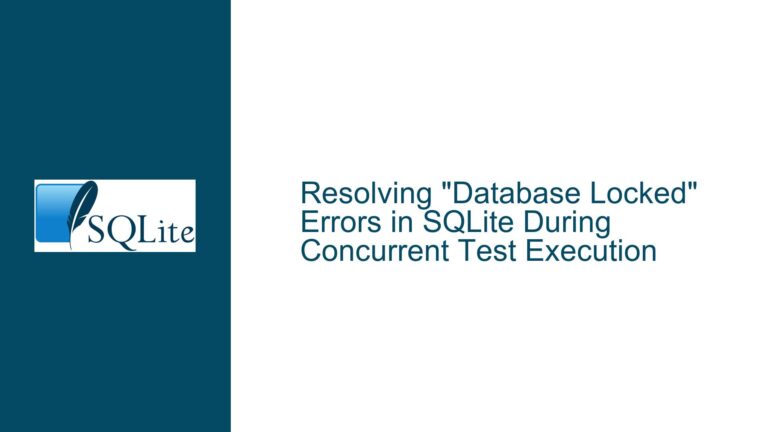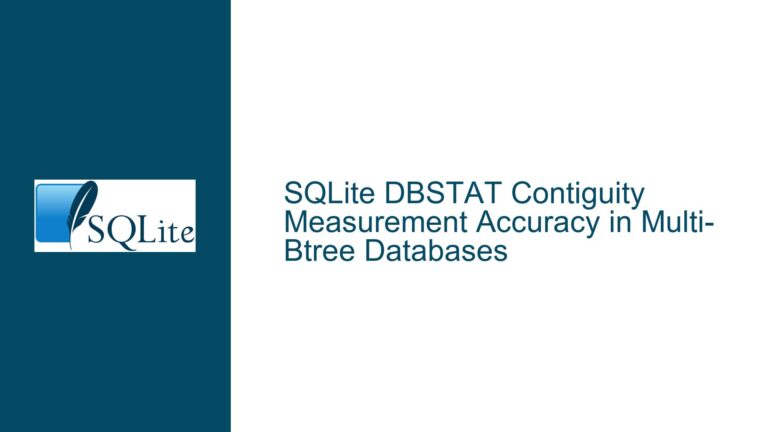the Impact of Index Column Length on SQLite Query Performance
The Role of Index Column Length in Query Execution Time
When working with SQLite, the length of the values in an indexed column can significantly impact query performance. This is particularly evident in large datasets, where the efficiency of index traversal becomes crucial. In the scenario described, a table with 400 million rows and a unique index on a column that initially contained zero-padded, prefixed strings saw a dramatic speed-up when the padding and prefix were removed, reducing the length of the indexed values. This change resulted in a query execution time reduction from 1617.126 seconds to just 6.794 seconds for a SELECT DISTINCT operation. This section will delve into why the length of index values can have such a profound effect on performance.
SQLite uses B-trees for its indexes, which are balanced tree data structures that allow for efficient data retrieval. The performance of a B-tree is influenced by the number of entries that can fit on a single page of the database file. Longer index values mean fewer entries per page, which in turn increases the depth of the tree. A deeper tree requires more disk I/O operations to traverse, as more pages need to be loaded into memory to reach the desired data. This is why reducing the length of the index values led to a significant performance improvement: more entries could fit on each page, reducing the number of pages that needed to be accessed and thus decreasing the overall query execution time.
The Misconception of Indexes as Hash Tables
A common misconception is that indexes in SQLite function like hash tables, where the length of the key has little impact on performance once the hash is computed. However, this is not the case. SQLite’s indexes are implemented as B-trees, not hash tables. In a B-tree, the length of the key directly affects the number of entries that can be stored on a single page. Longer keys reduce the number of entries per page, increasing the depth of the tree and the number of disk I/O operations required to traverse it. This misunderstanding can lead to suboptimal schema design choices, such as using unnecessarily long keys in indexed columns.
The confusion may arise from the fact that hash tables do offer constant-time complexity for lookups, regardless of the key length, once the hash is computed. However, B-trees, while providing logarithmic time complexity for lookups, are more sensitive to the size of the keys because they affect the tree’s structure and the number of disk accesses required. This distinction is crucial for understanding why the length of index values in SQLite can have such a significant impact on query performance.
The Impact of Disk I/O on Query Performance
In large databases, disk I/O is often the bottleneck for query performance. When executing a query that involves scanning an index, SQLite must load the relevant pages from the database file into memory. The longer the index values, the fewer entries can fit on each page, and the more pages need to be loaded. This increases the amount of disk I/O required, which can significantly slow down query execution, especially when dealing with hundreds of millions of rows.
In the given scenario, the original index values were zero-padded and prefixed, resulting in longer strings. This meant that fewer entries could fit on each page, increasing the number of pages that needed to be loaded from disk. By removing the padding and prefix, the length of the index values was reduced, allowing more entries to fit on each page. This reduced the number of pages that needed to be loaded, leading to a dramatic decrease in query execution time. This highlights the importance of considering disk I/O when designing database schemas and indexes, particularly for large datasets.
Optimizing Index Column Length for Better Performance
To optimize query performance in SQLite, it is essential to carefully consider the length of the values in indexed columns. Shorter index values allow more entries to fit on each page, reducing the depth of the B-tree and the number of disk I/O operations required. This can lead to significant performance improvements, especially for large datasets. In the scenario described, removing unnecessary padding and prefixes from the index values resulted in a 237x speed-up for the SELECT DISTINCT query.
When designing a database schema, it is important to strike a balance between the need for descriptive, human-readable keys and the performance implications of longer index values. In some cases, it may be beneficial to use shorter, more compact keys in indexed columns, even if this means sacrificing some readability. Additionally, consider using integer keys where possible, as they are typically more compact and efficient than string keys. By carefully optimizing the length of index values, you can significantly improve query performance and reduce the load on your database system.
The Importance of Query Plans in Performance Analysis
Understanding the query plan is crucial for diagnosing and optimizing query performance in SQLite. The query plan provides insight into how SQLite will execute a query, including which indexes will be used and how data will be accessed. In the scenario described, the query plan indicated that both queries were using a covering index, which means that the index contained all the data needed to satisfy the query, eliminating the need to access the underlying table. However, the significant difference in execution time suggests that the length of the index values had a substantial impact on the efficiency of the index traversal.
By enabling the EXPLAIN QUERY PLAN feature in SQLite, you can gain valuable insights into how your queries are being executed and identify potential bottlenecks. This can help you make informed decisions about schema design, index creation, and query optimization. In the given scenario, analyzing the query plan could have provided further confirmation that the reduction in index value length was the primary factor behind the performance improvement.
Best Practices for Index Design in SQLite
When designing indexes in SQLite, there are several best practices to keep in mind to ensure optimal performance. First, consider the length of the values in indexed columns and aim to keep them as short as possible without sacrificing necessary information. This can help reduce the depth of the B-tree and minimize disk I/O. Second, use integer keys where possible, as they are more compact and efficient than string keys. Third, consider the selectivity of the index; highly selective indexes (those with many unique values) are generally more effective than those with low selectivity.
Additionally, be mindful of the trade-offs between index size and query performance. While adding more indexes can improve query performance, it can also increase the size of the database file and the overhead of maintaining the indexes. Therefore, it is important to carefully evaluate the need for each index and consider the impact on overall database performance. By following these best practices, you can design efficient indexes that support fast query execution and minimize the load on your database system.
Conclusion
The length of the values in an indexed column can have a significant impact on query performance in SQLite, particularly for large datasets. By reducing the length of index values, you can increase the number of entries that fit on each page, reduce the depth of the B-tree, and minimize disk I/O. This can lead to substantial performance improvements, as demonstrated by the 237x speed-up in the scenario described. Understanding the role of index column length, the structure of SQLite’s B-tree indexes, and the impact of disk I/O is crucial for optimizing query performance and designing efficient database schemas. By following best practices for index design and analyzing query plans, you can ensure that your SQLite databases perform well even under heavy loads.






